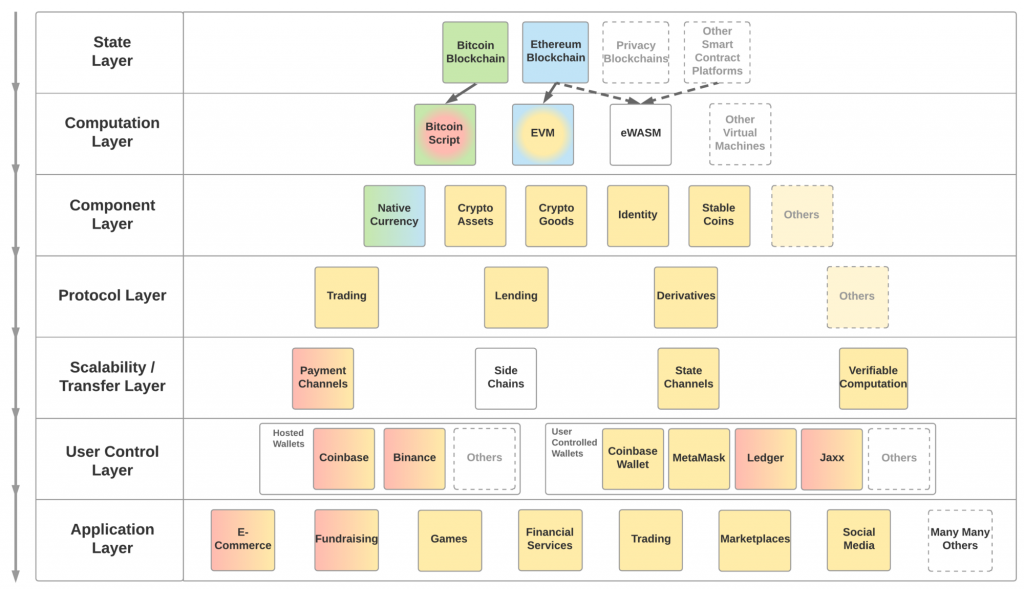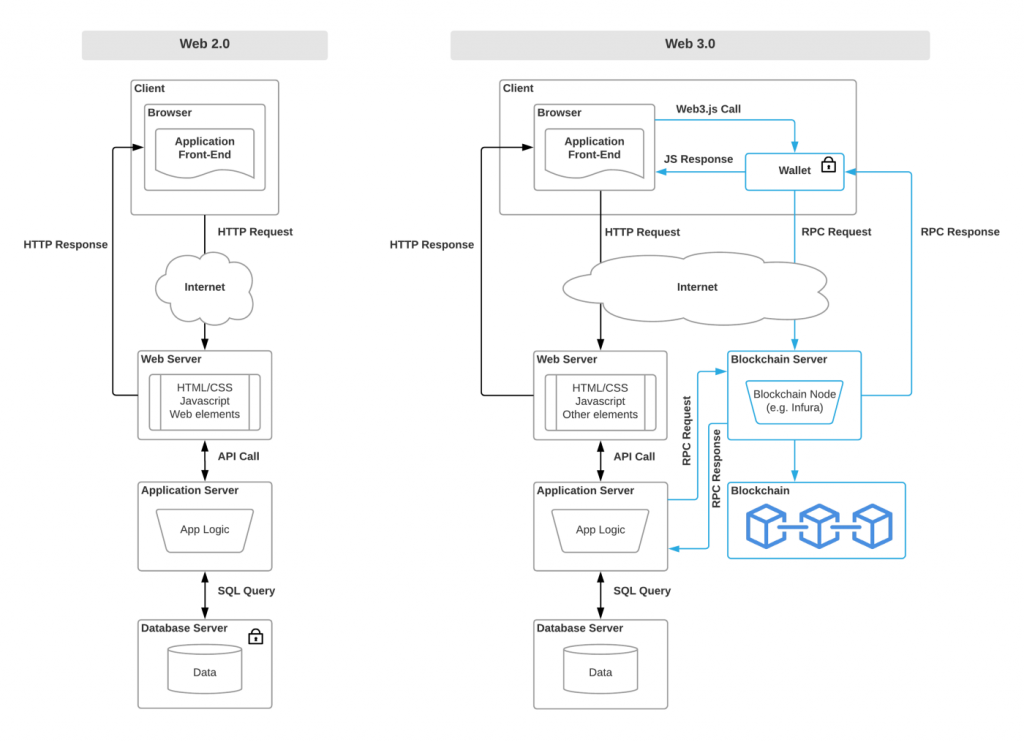Coinbase’in iş geliştirmeden sorumlu yöneticisi Emre Tekişalp, Medium üzerinde kaleme aldığı makalede, Web 3’ün geliştirilmesinin arkasında yatan motivasyonu ve teknolojiyi üç ana başlık altında detaylandırdı.
“Neden?” “Ne?” ve “Nasıl?” şeklinde üç ana başlık halinde hazırlanan makale, internetin gelişimindeki bir sonraki adım olarak görülen Web 3 masaya yatırılıyor. İlk bölümde bugün kullandığımız internetin yetersiz kaldığı noktalar ve Web 3 ile gelecek geliştirmeler detaylandırılırken, ikinci bölüm Web 3 ile neyin ifade edildiğine odaklanıyor. Son bölümde ise geliştiricilerin bu yeni nesil internet üzerinde nasıl geliştirme yapabileceği anlatılıyor. Makalenin tamamına buradan ulaşabilirsiniz.
Part 1: Why
Today’s world wide web, or the internet, has two key missing properties:
- It doesn’t hold “state”, independent of trusted operators
- It doesn’t have a native mechanism to transfer state
Lack of state is a result of the simplicity of the protocols that the web is built on, such as HTTP and SMTP. At any moment, if you were to query a node (a device connected to the internet) about its history or current state, it has no idea. From a user’s perspective, this would be like using the internet for the first time from a new browser (no history, favorites, saved settings or auto-complete), every time you use anything connected to the internet. Imagine having to submit your user information every time you’re trying to use a service or downloading all your favorite apps every time you open your device. The internet would not be useable, or at least extremely inefficient.
State, however, is crucial to the development of services and applications as it can represent value. As such, two key developments have remedied the state drawback. First, as Brendan Eich highlights, cookies were invented in order for web based applications written in JavaScript to preserve state on each local device. The problem with cookies however is that they are created and controlled by service providers, not the user. The user does not have any control over which provider is giving them state or has access to their state.
The second development that addressed the lack of state is centralized service providers that hold user state on their own machines. Today’s large internet companies like Google and Facebook all hold the state, and hence the value created, by billions of people. There’s nothing inherently wrong with this, as their users have benefited from services and value created by the same companies. The problem lies in how the internet benefits these centralized companies way more than it does the public.
The second key missing property of the internet, the lack of a native mechanism to transfer state, is partly a by-product of the first issue. If you can’t hold state (and the value it creates), you can’t transfer it. The ability to easily and efficiently transfer value is at the heart of economic development and modern finance. Any improvement in how efficiently you can transfer value has cascading positive effects. Today’s internet has made it easier to transfer information by orders of magnitude and thus has created immense potential for new businesses and services. However, if there’s no easy way for businesses to trade value, they need to find another way to profit from their services.
This is why, over the years, the web’s incumbent business model has become advertising, as advertising businesses are the only ones that can efficiently store and transmit the state of billions of users. Again, there is nothing inherently wrong with advertising. But the problem, this time, is three-fold:
- Third-party intermediaries facilitate and profit from every single advertising transaction;
- Advertising favors established businesses, which puts new businesses at a disadvantage, limiting the economy’s growth potential;
- A richer advertising economy is reliant upon more user data (which feeds ad models), creating misaligned incentives with users and bad UX.
A Direction for the Internet
The web, in and of itself, is a technological development. It’s just a bunch of pipes, indifferent to what humans do with it. Humans, ultimately, need to decide where to point it. Over the years, it’s become obvious that its current direction will not benefit those who aren’t already benefiting from it. For the web’s next decade or two, a better direction would be to facilitate:
- The creation of native economic value by any participant; and
- The transfer of this native value to any participant.
With the invention of blockchains, thanks to Satoshi Nakamoto and other academics before her/him/them, we now have a way for each participant in a network to hold and transfer state in a digitally native format. Many developers and entrepreneurs around the world have started to build (or #BUIDL, as the case may be) on this new state layer. With the advent of open platforms such as Ethereum, this is becoming easier by the day. As people become aware of what these new capabilities allow them to do, they have started to rally around the cry for an internet that is more open and fair, otherwise known as Web 3.
Part 2: What
As explained in Part 1, today’s internet is a stateless internet — its participants can’t hold their own state, nor transfer it from one to another, natively. Blockchains, starting with Bitcoin, gave us a way to hold state in a digitally native way. Those of us in the crypto and blockchain ecosystem have started to refer to this new fundamental capability as Web 3. Although we’re still in the very early days, we’re starting to have a rough understanding of what benefits it will bring. L4, for example, has put together some great insights on these benefits.
This part is about what the Web 3 stack looks like today, and likely in the future:

The Web 3 Stack — A modular framework
The layers in the framework above start from the top and get built down the y-axis. Colors represent compatibility between modules in the different layers. For example, today’s Crypto Goods (yellow), as depicted above, are compatible with EVM (blue to yellow) but not with the Bitcoin Script (green to red). EVM, in turn, is compatible with the Ethereum Blockchain (blue), but not with the Bitcoin Blockchain (green). This allows us to place in to the framework a future Crypto Good that is compatible with the Bitcoin Script and hence is recorded on the Bitcoin Blockchain (although this is highly unlikely due to technical challenges). Such a modularity is crucial to the robustness of Web 3, as upgrading one of the layers should not require a complete rewrite of everything below it. It’s also important to note that although the modules within each layer may end up looking completely different in 5 years, the layers themselves are intended to be comprehensive and cover all the pieces that make up Web 3.
Part 3: How
In Part 1, we reviewed how today’s internet is a state-less internet — its participants can’t hold their own state, nor transfer it from one to another, natively. Blockchains, starting with Bitcoin, gave us a way to have a stateful web of computers. Those of us in the crypto and blockchain ecosystem have started to call this new internet as Web 3, which we reviewed in Part 2.
Web 3 adds a whole new infrastructure layer for applications to interact with, as well as new client functionalities and requirements. The users also need to learn new UX concepts to be able to use these applications. As such, the architecture of Web 3 applications introduce additional elements to the current Web 2.0 framework, as well as new building blocks and tools for a developer to get familiar with.
Web 2.0 vs Web 3.0 Architecture
A simplistic version of today’s Web 2.0 architecture includes a client software, usually a browser or a self-contained application, and a suite of servers providing content and logic, which are all controlled by the same entity — let’s call it Game Co. In this model, Game Co. has sole control over who may access its servers’ contents and logic, as well as the track record of which users own what and how long that content is kept live. There are many examples in the pages of technology history of how internet companies have changed the rules on their users or stopped their service, with users having no power to preserve the value they’ve created.
Web 3.0 architecture leverages what’s enabled by a universal State Layer. It does this by allowing two things:
- Allowing applications to place some or all of their content and logic on to a public blockchain. Contrary to standard Web 2.0, this content and logic can become public and accessible by anyone.
- Allowing users to exert direct control over this content and logic. Unlike Web 2.0, users don’t necessarily need accounts or privileged API keys to interact with what’s on the blockchain.
Web 3 applications enable this with the help of two key infrastructure pieces:
- Wallets: Beyond just being the User Control Layer for the Web 3 stack, modern wallets, such as Coinbase Wallet, interact with the main client front-end to allow a seamless user experience. They do this by allowing applications to send requests to the wallet itself using standard libraries, web3.js being the most popular of these. A sample web3.js call can be a payment request, asking the user to confirm that the wallet can send a specified amount of funds to the application’s address. When the user accepts, two things happen: 1) the wallet lets the application front-end know with a response, so it can present a “Payment Submitted” screen, 2) the wallet makes an RPC call to the blockchain server to submit the approved transaction to the blockchain. This is where the second infrastructure piece comes into play.
- Blockchain Node: There are two types of agents that constantly monitor and engage with a blockchain — miners and nodes. Miners directly maintain and run the blockchain, whereas, nodes monitor and submit transactions to the blockchain. One can think of them analogous to ISPs versus cloud services providers (e.g. AWS). Similar to how most applications today use AWS’s services to run their application backends, blockchain node providers, such as Infura, do the same with blockchain nodes. When a wallet wants to submit a transaction to the blockchain, or query state information from the blockchain, it makes a call to the node provider. Applications’ app servers can also interact with the node providers themselves, to keep the app’s logic up to date, by making similar RPC calls.
Summary
In Part 3, I aimed to summarize the modifications Web 3 brings to the architecture of applications and what developers should know when starting to build Web 3 apps. A great resource for beginners is Cryptozombies, which is a fun workshop teaching anyone how to create their first Web 3 app.
Although the way to build Web 3 apps will change in many ways as the infrastructure around it evolves, what’s key is that apps are being built today. It’s the wild west of the web as we know it and a lot of really smart teams are starting to tackle the challenges and opportunities made available.
This concludes our three part post on Understanding Web 3 — A User Controlled Internet. Here at Coinbase, we are building products to support an Open Financial System, and we see Web 3 as the way developers all around the world will build the products and businesses that make this vision a reality. If you want to join us and the rest of the ecosystem by building your own Web 3 application, make sure to check out Coinbase Wallet to get access to the many users who are already using DApps! We’re also hiring for many different roles and investing in the companies that will build the decentralized web with us.






